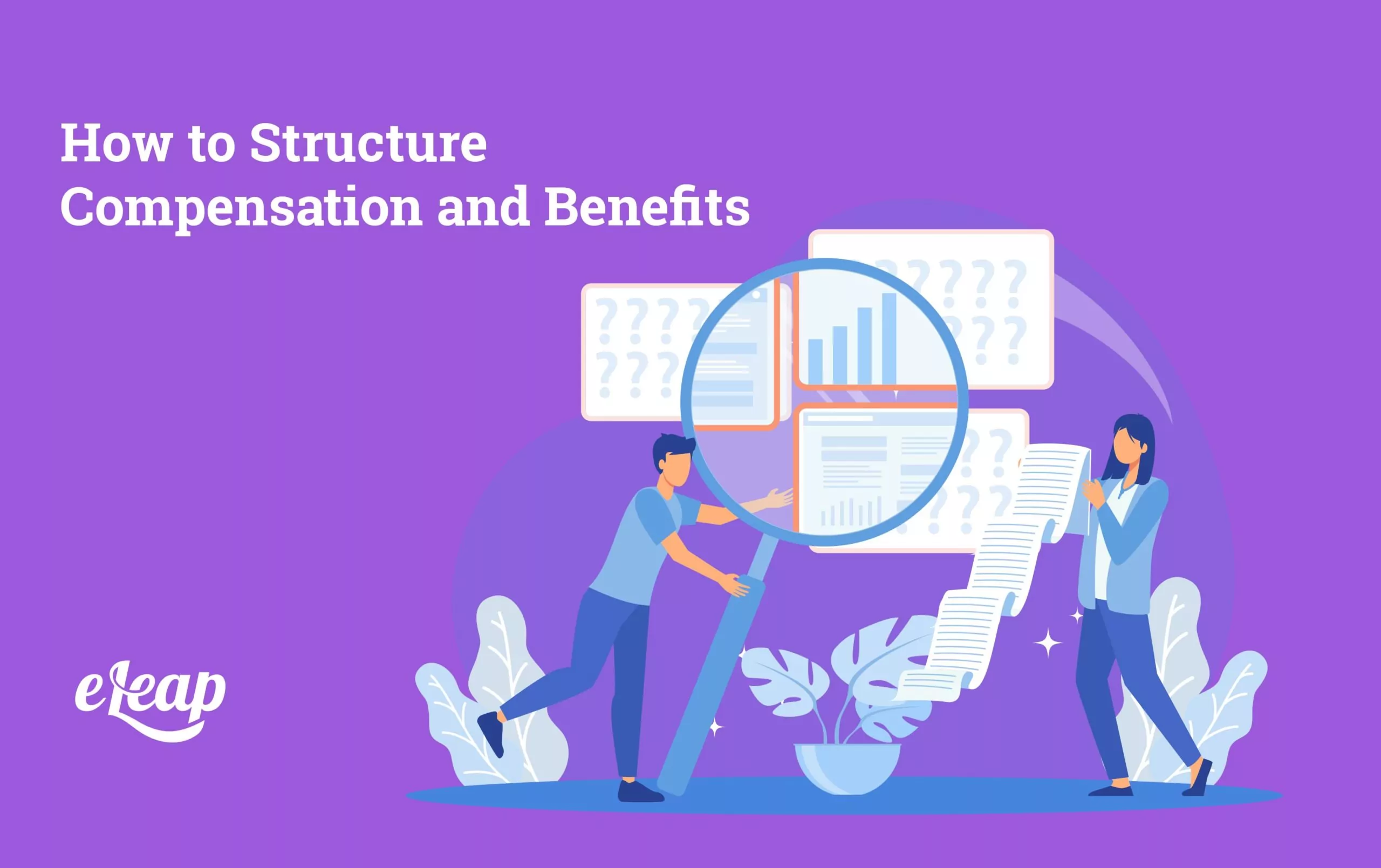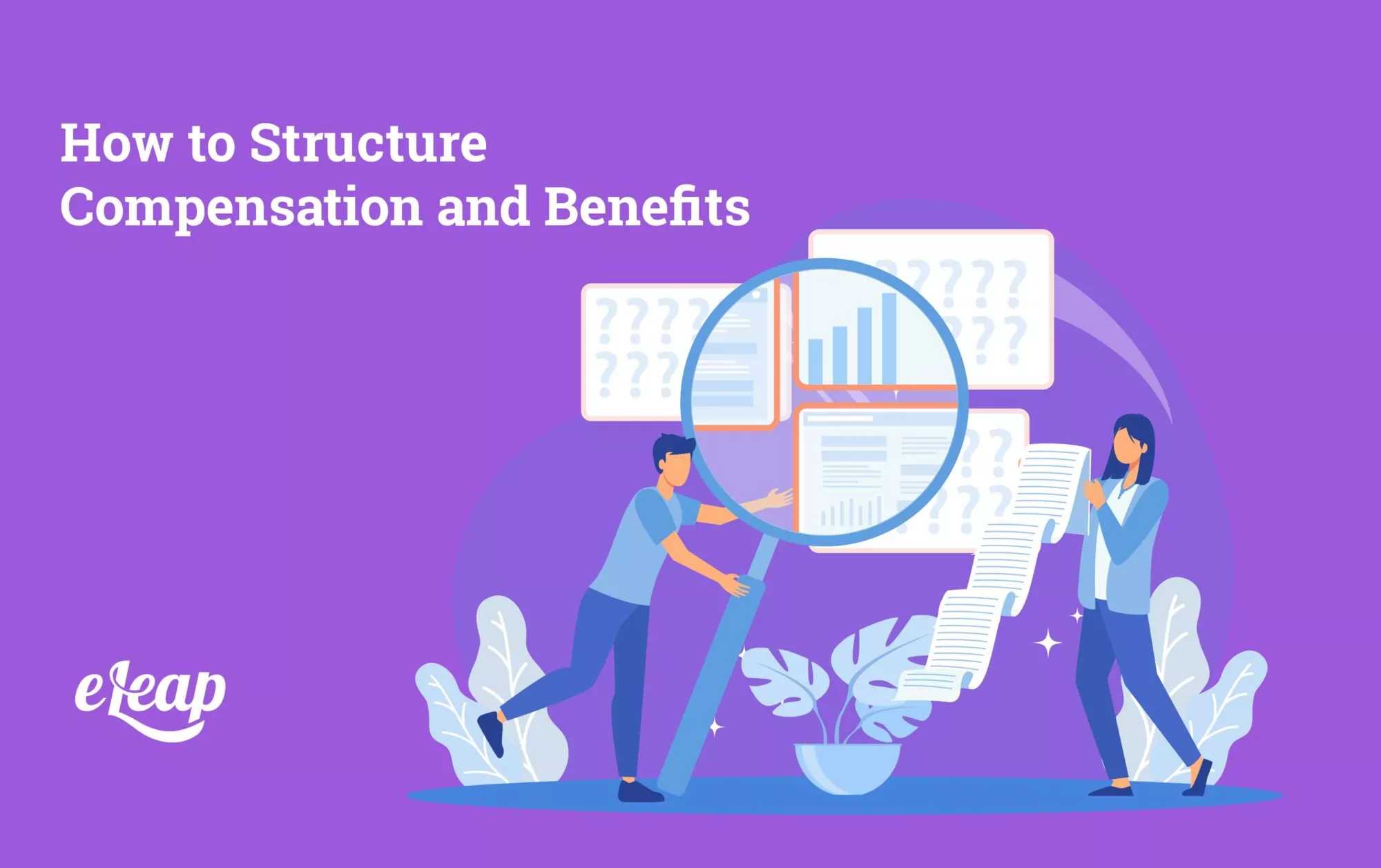How to Structure Compensation and Benefits

When it comes to attracting and retaining top talent, the structure of your compensation and benefits package can make all the difference. A well-crafted package helps you stand out in a competitive job market and plays a crucial role in maintaining employee satisfaction and loyalty. In today’s dynamic business environment, where the expectations and needs of employees are continually evolving, understanding how to successfully structure these components is critical for building a successful organization.
Compensation and benefits go beyond financial incentives; they reflect your company’s values and commitment to its employees’ well-being. This guide will walk you through the essential components of structuring a comprehensive compensation and benefits package, offering practical insights and strategies that help you design an attractive and competitive offer for your workforce. See how eLeaP’s Performance Management Platform helps you apply these insights to drive better results.
Types of Compensation
Base Salary

Base salary is the foundational component of any compensation package. It refers to the fixed amount employees earn for their job, usually paid monthly or biweekly. Setting a competitive base salary requires a thorough understanding of industry standards and regional pay scales. It’s crucial to ensure that your basic wage matches the abilities, experience, and responsibilities needed for each function.
A software engineer in San Francisco will get paid more than in a smaller city due to the higher cost of living and competitive job market. By conducting regular salary reviews and market research, you can ensure that your base salaries remain attractive and equitable.
Bonuses and Incentives
Bonuses and incentives are intended to reward employees for exceptional performance and to motivate them to achieve organizational goals. These can be structured in various ways, including annual bonuses, performance bonuses, and spot awards. Performance-based bonuses are often tied to specific targets or objectives, making them a powerful tool to drive productivity and align individual efforts with company success.
Incentives, such as profit-sharing or sales commissions, offer employees additional earning potential based on the company’s performance or individual achievements. Implementing a well-structured bonus system can enhance employee motivation and drive better results, ultimately benefiting both the employees and the organization.
Equity and Profit Sharing
Equity and profit-sharing schemes give employees a share in the company’s success. Equity plans, such as stock options or restricted stock units (RSUs), give employees ownership shares, aligning their interests with the company’s long-term success. This process can attract employees at startups or high-growth companies, where equity can offer substantial future value.
Profit-sharing plans distribute a portion of the company’s profits to employees, usually based on a predetermined formula. These plans serve as a financial incentive and foster a sense of ownership and shared responsibility for the company’s performance.
Health and Wellness Benefits
Health and wellness benefits are crucial in ensuring that employees maintain their physical and mental well-being. Comprehensive health insurance plans, including medical, dental, and vision coverage, are fundamental to any benefits package. Additionally, wellness programs that promote healthy lifestyles, such as gym memberships or mental health support, can enhance employee satisfaction and reduce absenteeism.
Providing robust health and wellness benefits helps attract top talent and demonstrates your commitment to your employees’ overall well-being, contributing to a positive workplace culture.
Retirement Plans
Retirement plans, such as 401(k) or pension plans, are essential for helping employees prepare for their future. Offering a retirement plan with company-matching contributions can significantly increase its attractiveness. Employees value the opportunity to save for retirement, and a competitive retirement plan can be a critical factor in long-term employee retention.
Ensuring your retirement plan is competitive and aligned with industry standards will help you stay ahead in the talent market and provide valuable financial security for your employees.
Paid Time Off and Leave Policies
Paid time off (PTO) and leave policies are vital for maintaining work-life balance and employee well-being. Offering a generous PTO policy that includes vacation days, sick leave, and personal days can contribute to a positive work environment and reduce burnout.
Additionally, flexible leave policies, such as parental or bereavement leave, demonstrate empathy and support for employees during significant life events. These policies not only enhance employee satisfaction but also improve loyalty and productivity.
Additional Perks
Additional perks, such as employee discounts, tuition reimbursement, or flexible working arrangements, can add significant value to your benefits package. While these perks may not be as substantial as health or retirement benefits, they can enhance your overall offering and appeal to different employee needs and preferences.
For instance, providing tuition reimbursement can assist employees in their development, while offering flexible working arrangements can improve work-life balance. These benefits can differentiate your company from competitors and foster a more engaging and supportive workplace.
Structuring a Compensation and Benefits Package
Aligning with Business Goals
It’s vital to align it with your company’s overall business goals and strategy to create a successful compensation and benefits package. This step involves assessing how your compensation structure supports your company’s objectives, such as attracting top talent, retaining key employees, or driving specific business outcomes.
For example, if your company is focused on innovation and growth, offering equity or performance-based incentives might be more effective in motivating employees to contribute to these goals. You can create a more cohesive and targeted approach to employee rewards by aligning your compensation strategy with your business objectives.
Benchmarking Against Industry Standards
Benchmarking your compensation and benefits package against industry standards is crucial for maintaining competitiveness. Conducting market research and analyzing compensation data from similar companies can provide valuable insights into current trends and help you ensure that your offerings are attractive and equitable.
Utilizing tools and resources to benchmark your compensation practices can also help you identify areas for improvement and make informed adjustments to stay ahead in the talent market.
Balancing Cost and Employee Satisfaction
Striking the right balance between cost and employee satisfaction is crucial to designing a successful compensation and benefits package. It is essential to provide competitive and appealing benefits. It is also necessary to efficiently manage costs to ensure sustainability.
Regularly reviewing your compensation and benefits offerings, analyzing their impact on employee satisfaction and organizational performance, and making data-driven adjustments can help you achieve this balance. Utilizing solutions like eLeaP for streamlined benefits management can also support effective cost control and enhance your overall benefits administration.
Legal and Financial Considerations
Compliance with Labor Laws
Understanding the financial implications of your compensation and benefits package is essential for effective budgeting and cost management. This process involves analyzing direct costs such as salaries, bonuses, and benefits, in addition to associated indirect expenses related to employee turnover and productivity.
By carefully assessing these financial factors and using tools like eLeaP to manage and analyze compensation data, you can make informed decisions and maintain a financially sustainable benefits program.
Financial Implications
Understanding the financial implications of your compensation and benefits package is essential for effective budgeting and cost management. This involves analyzing the direct costs of salaries, bonuses, and benefits, as well as the indirect costs associated with employee turnover and productivity.
By carefully assessing these financial factors and using tools like eLeaP Software to manage and analyze compensation data, you can make informed decisions and maintain a financially sustainable benefits program.
Best Practices for Implementation
Effective communication of your compensation and benefits package plays an essential role in ensuring that employees comprehend and appreciate their rewards. Employees benefit from precise information on package components, such as how bonuses accumulate. And perks are accessed.
Regularly updating employees about any changes or enhancements to the package and addressing any questions or concerns they may have will contribute to greater transparency and trust.
Regular Review and Adjustment
Regularly reviewing and adjusting your compensation and benefits package is critical for keeping it relevant and competitive. This stage includes assessing market trends, employee feedback, and organizational changes to ensure that your offerings continue to meet the needs of your workforce.
Implementing a structured review process and using data-driven insights to make adjustments can help you maintain a dynamic and effective compensation strategy.
Using Employee Feedback
Gathering and utilizing employee feedback is valuable for improving your compensation and benefits package. Conducting surveys or focus groups to understand employees’ perceptions and preferences can provide insights into areas for improvement and help you tailor your offerings to match their needs.
By actively listening to employees and incorporating their feedback, you can enhance satisfaction and engagement, leading to a more motivated and loyal workforce.
Case Studies and Examples
Examining successful compensation and benefits strategies from leading companies can provide valuable insights and inspiration. For example, companies implementing innovative approaches to bonuses, equity plans, or wellness programs see improved employee engagement and retention.
Studying these examples and analyzing their impact on employee satisfaction and company performance can offer practical ideas for enhancing your compensation and benefits package.
Lessons from Industry Leaders
Learning from industry leaders who have successfully navigated the complexities of compensation and benefits structuring can provide valuable lessons. These leaders often share their experiences and strategies through case studies, interviews, or industry reports, offering practical tips and best practices.
Incorporating these lessons into your approach can help avoid common pitfalls and create a more effective and competitive benefits package.
Conclusion
In conclusion, structuring a well-rounded compensation and benefits package is essential for attracting, retaining, and motivating employees. You can create an attractive and effective rewards program by understanding the different components of compensation, offering comprehensive benefits, and aligning your package with business goals. Utilizing tools like eLeaP can also streamline benefits management and enhance your overall strategy.
Regularly reviewing and adjusting your offerings based on market trends and employee feedback will help you maintain a competitive edge and ensure that your compensation and benefits package continues to meet the needs of your workforce. With a thoughtful and strategic approach, you can build a successful and engaging compensation program that drives organizational success and employee satisfaction.